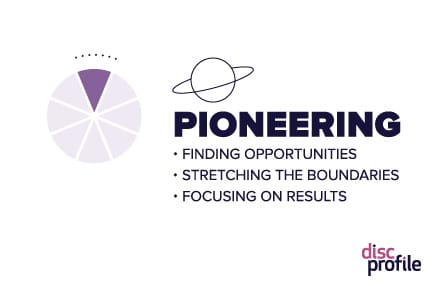The pioneering dimension of leadership
The Everything DiSC®-based typology of leadership styles helps determine your primary leadership dimension and identify areas for development. The most effective leaders use all eight dimensions of leadership as needed and when necessary. But everyone has the style they gravitate to.
Pioneering leaders are adventurous—driven to keep seeking bigger and better roles, products, and experiences. They inspire a team to venture into uncharted territory. They have a high need for freedom and see opportunities where others don’t. They are confident in their vision and enjoy winning others to their point of view. We get caught up in their passion to grow, expand, and explore.
On the other hand, pioneering leaders might ignore the needs of their followers, or just not take the time to understand their reality. Their bias toward action can get their team moving quickly, but it can also cause them to overlook systemic problems.
Who is a pioneering leader?
In terms of the Everything DiSC model, the pioneering dimension is located on the northern side of the model, which means that pioneering leaders tend to be fast-paced and outspoken. Pioneering leaders are aggressive about taking risks and enjoy the challenge of rallying people together to create an environment where creativity is encouraged.
Strengths of the pioneering leader:
- They tend to be good at initiating change.
- They often trust their gut instincts.
- They’re able to bring people together to achieve their goals.
- They tend to be inspiring.
- They’re not afraid to try something new.
- They’re comfortable taking the lead.
- They set stretch goals for themselves and others.
- They aren’t afraid to take risks.
Goals: Quick action, new opportunities, exciting breakthroughs
Would increase effectiveness through: Patience, humility, consideration
Source: The 8 Dimensions of Leadership

What can we learn from pioneering leaders?
Be aggressive about exploring opportunities
This is a great dimension to draw upon if you’re an entrepreneur in the first stages of building a business or brand. It’s also good to develop these behaviors during times when things seem to be just coasting along. It’s very common for managers, peers, and direct reports to want their leaders to “be more active about finding new opportunities,” according to Wiley’s database of leadership assessment responses (The Work of Leaders, 2013). The pioneering leader reminds us that innovation doesn’t happen without active exploration. In other words, the next big thing isn’t hiding under your desk.
“Leaders are pioneers—people who are willing to step out into the unknown. They search for opportunities to innovate, grow, and improve.”
Leaders lead change and stretch the boundaries
Are you in a period of stability or one of stagnation? People tend to overstate risks and underemphasize potential rewards. The pioneering leaders aren’t afraid to do what’s never been done before. They encourage growth for the organization and for the people around them. They stay current with best practices and opportunities to stretch beyond the status quo. You might be working hard to create a stable environment for your employees, but you need to be sure you aren’t also quashing the creativity of the entrepreneurial spirit around you.
“Let people know that innovative thinking is a part of everyone’s job, regardless of their function or level of responsibility.”
Learn to take leaps of faith
Careful planning has its place and its rewards, but sometimes bold action is necessary. The first to market often has the advantage. The faith you show in your ideas inspires others. Not taking a chance can present its own dangers. If you’re risk averse, allow yourself time for a reasonable amount of analysis and then act. Don’t let the research, risk assessments, and worry stop you from taking the leap.
“The truth is that challenge is the crucible for greatness… And the truth is also that you either lead by example or you don’t lead at all. You have to go first as a leader.”
The pitfalls of pioneering-only leadership
Overall, the natural pioneering leader could be more effective by showing greater consideration, humility, and patience.
As you lead your team into new territory, you can’t forget the needs of the rest of the team. Understand that their needs are probably very different from yours. They might worry that your drive and enthusiasm are taking them off a cliff or into territory they aren’t ready to explore. Is your team being pulled along in your wake or are they truly on the journey with you? Have you given consideration to their concerns and needs?
A clear vision in one’s own head doesn’t always translate clearly to everyone else, even when presented with confidence and charm. Pioneering leaders tend to gloss over the specifics or appear to others as reacting on the fly. Their high ego needs can be an issue if their charisma fails, causing others to feel pushed, intimidated, or insincerely flattered by them. If a leader inspires but does not support, he or she can lose followers along the way.
Related resources
Be aggressive about exploring opportunities
- Challenge the Process by Creating Original Ideas, Flashpoint Leadership
- Curiosity, Not Coding: 6 Skills Leaders Need in the Digital Age, Harvard Business School Working Knowledge
- The Leadership Opportunity in Our Future of Perpetual Uncertainty, Forbes
Leaders lead change and stretch the boundaries
- CEOs, Here’s How to Lead in an Era of Constant Change, Harvard Business Review
- Choosing to grow: The leader’s blueprint, McKinsey & Company

